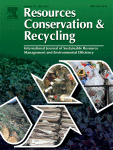Ver ítem
- xmlui.general.dspace_homeCentros Regionales y EEAsCentro Regional Santa FeEEA OliverosArtículos científicosxmlui.ArtifactBrowser.ItemViewer.trail
- Inicio
- Centros Regionales y EEAs
- Centro Regional Santa Fe
- EEA Oliveros
- Artículos científicos
- Ver ítem
Environmentally sound resource valuation for a more sustainable international trade : case of argentine maize
Resumen
This study analyzed costs and benefits for Argentina when trading maize grain. Assigning an appropriate value to
traded resources involves a comprehensive assessment of all kinds of sources driving the process, in order to
avoid their misappropriation and non-profitable use, while at the same time enhancing the environmental
performance of the region for the long term. Increasing amounts of slowly-renewable and non-renewable resources
invested in
[ver mas...]
This study analyzed costs and benefits for Argentina when trading maize grain. Assigning an appropriate value to
traded resources involves a comprehensive assessment of all kinds of sources driving the process, in order to
avoid their misappropriation and non-profitable use, while at the same time enhancing the environmental
performance of the region for the long term. Increasing amounts of slowly-renewable and non-renewable resources
invested in producing intensive cash crops do not necessarily contribute to further development of local
enterprises, nor does this strategy consider valuable contributions by local ecosystem services. The emergy
method was applied to assess resource and environmental support used in production and trade of maize grain in
the northern part of Argentina’s Pampas Region, in years 2009–10 and 2012–13. Exports were calculated for
commercial periods 2010–11 and 2013–14. Results showed that intermediate organizations trading with importing
countries through international grain traders (Emergy–to-Exchange Ratio, EER, for Argentina =0.51)
exported more environmental resources (emergy associated with exported grain) than emergy imports associated
with monetary returns from traders to Argentina. This situation places the country in an unfair exchange.
When trade was performed through national trade organizations, the EER =0.91, resulting in a smaller disparity.
Resource trade imbalance clearly appears when it is measured in emergy terms but not when it is accounted
for in monetary units. This study provides data on which to open discussion and inform trade and
production strategies that could help Argentina avoid jeopardizing its own natural resources in the long term.
[Cerrar]

Autor
Rotolo, Gloria Claudia;
Francis, Charles A.;
Ulgiati, Sergio;
Fuente
Resources, conservation & recycling 131 : 271–282. (2018)
Fecha
2018
ISSN
0921-3449
Formato
pdf
Tipo de documento
artículo
Palabras Claves
Derechos de acceso
Restringido
 Excepto donde se diga explicitamente, este item se publica bajo la siguiente descripción: Creative Commons Attribution-NonCommercial-ShareAlike 2.5 Unported (CC BY-NC-SA 2.5)
Excepto donde se diga explicitamente, este item se publica bajo la siguiente descripción: Creative Commons Attribution-NonCommercial-ShareAlike 2.5 Unported (CC BY-NC-SA 2.5)

